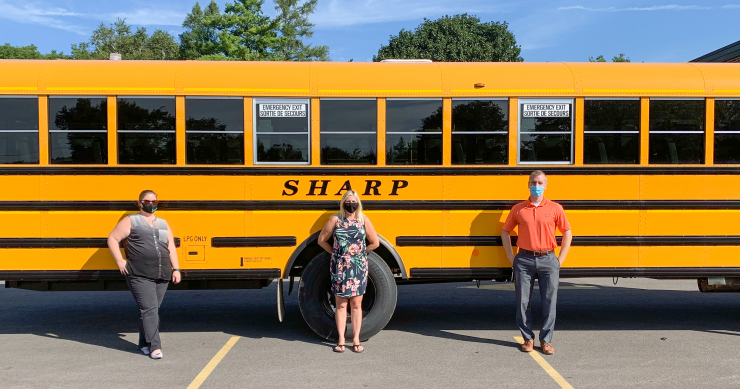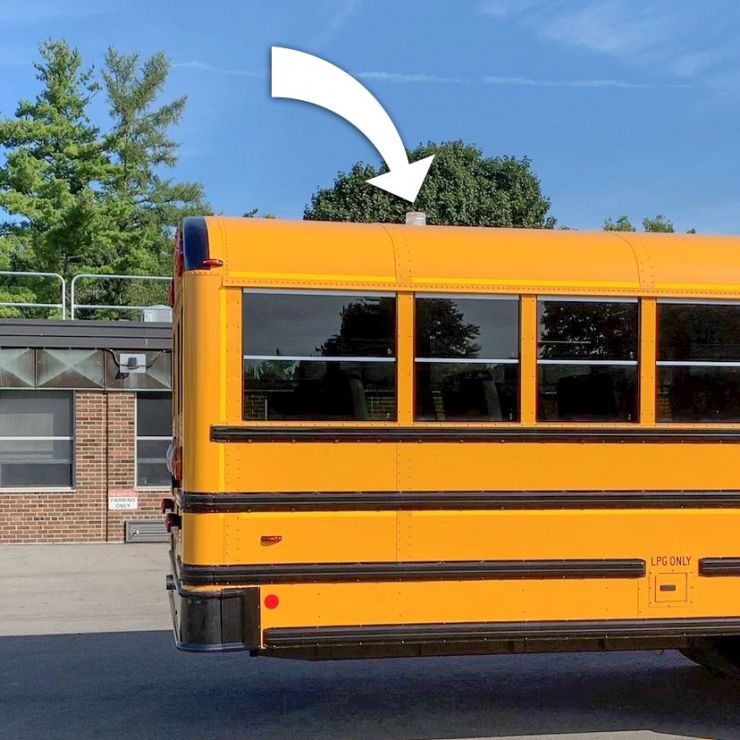
From left to right: Office Administrator Lindsay Grace, Regional Manager Crystal Williamson and Manager of Transportation Services Philip Kuckyt.
School Buses are Lighting the Way for Safety as Students Return
The start of school is always a good time to review road safety, and this year, motorists and pedestrians out and about in Haldimand, Norfolk, and Brant will notice a new feature meant to make the trip to and from school even safer for students.
“All school buses in our district are now equipped with a white flashing strobe light, located on the back third of the roof of the school bus,” explains Philip Kuckyt, Manager of Transportation for Student Transportation Services Brant Haldimand Norfolk (STSBHN). “The strobe light will be activated while the bus is performing its route in order to bring additional attention to the vehicle, and to help motorists note that students may be boarding or de-boarding when the vehicle comes to a stop.”

Right: An arrow indicates the location of the new strobe light on the school bus roof.
Unlike the majority of vehicles on the road, school buses make frequent stops in addition to obeying stop signs and traffic lights required of all drivers – and these stops are often at locations other drivers may not anticipate. The new light feature on school buses adds another element of visibility, which is especially important during foggy weather conditions.
“The farther away you can see a moving or stopped bus, the better you can control your own vehicle when sharing the road with it,” Kuckyt points out.
These lights are not to be confused with the flashing panic light seen on the back of some taxi cabs, meant to alert the public and police that the driver may be in trouble. The purpose of the school bus’s strobe light is simply to make the bus more visible when it’s transporting students on the trip to and from school. The public can be assured that everything is functioning as normal when they see this light in action, and to take extra care.
For those looking for a refresher lesson in back-to-school road safety, Kuckyt has these reminders: “Give the bus space, as it will be making frequent stops, and don’t pass a bus when its overhead lights are engaged and the bus’s stop arm is out, as students entering or exiting the bus may be crossing the road.”
Grand Erie’s Multi-Year Plan includes Environment as one of its key pillars, and works to ensure that student transportation – an extension of the school environment – is a safe, welcoming experience for all.
Photos by Grand Erie Communications
Healthy Bites Success for Graham Bell-Victoria Students
Graham Bell-Victoria School has been presented with a GOLD award of recognition and achievement in the Healthy Bites Program. The staff and students have worked hard and enjoyed the “fruits” of their labour as they have now been recognized with GOLD!
Throughout the year, Sonia Martin, school health nurse with the Brant County Health Unit, has lead our staff and students in a variety of healthy eating awareness activities. These included a Mystery Fruit and Vegetable contest, a trivia question in the monthly newsletter, and healthy fruit and vegetable snacks every Friday. These tasty treats, prepared by the grade 4-5 class were a big hit and helped us learn about the benefits of eating healthy.
Next year the program will be expanded to Healthy Steps and Healthy Bites, a program in which we will learn about and practice healthy eating and healthy activity. Congratulations, Graham Bell!
Voluntary Aboriginal Self-Identification
The Grand Erie District School Board recognizes the importance of school success for Aboriginal students. Our dedicated staff members are committed to improving services and programs for Aboriginal students attending school in the Board.
With a goal to improve the school experience for all Aboriginal students, the Board encourages the development of strong partnerships with Aboriginal families, communities and organizations, both on and off the reserve.
Through the Voluntary Aboriginal Self-Identification process, Aboriginal parents and students will have access to additional support services, including educational, social, and emotional supports that focus and foster Aboriginal identity, culture and values.
There are three categories of Voluntary Aboriginal Self-Identification – First Nation, Métis, or Inuit.
Your child may bring a GEDSB Voluntary Aboriginal Self-Identification form home or if not, you can contact your child’s school to receive a form. You can also, visit the Aboriginal Education section under the Program tab at www.granderie.ca for more information and a copy of the Voluntary Self-Identification form.
More News

